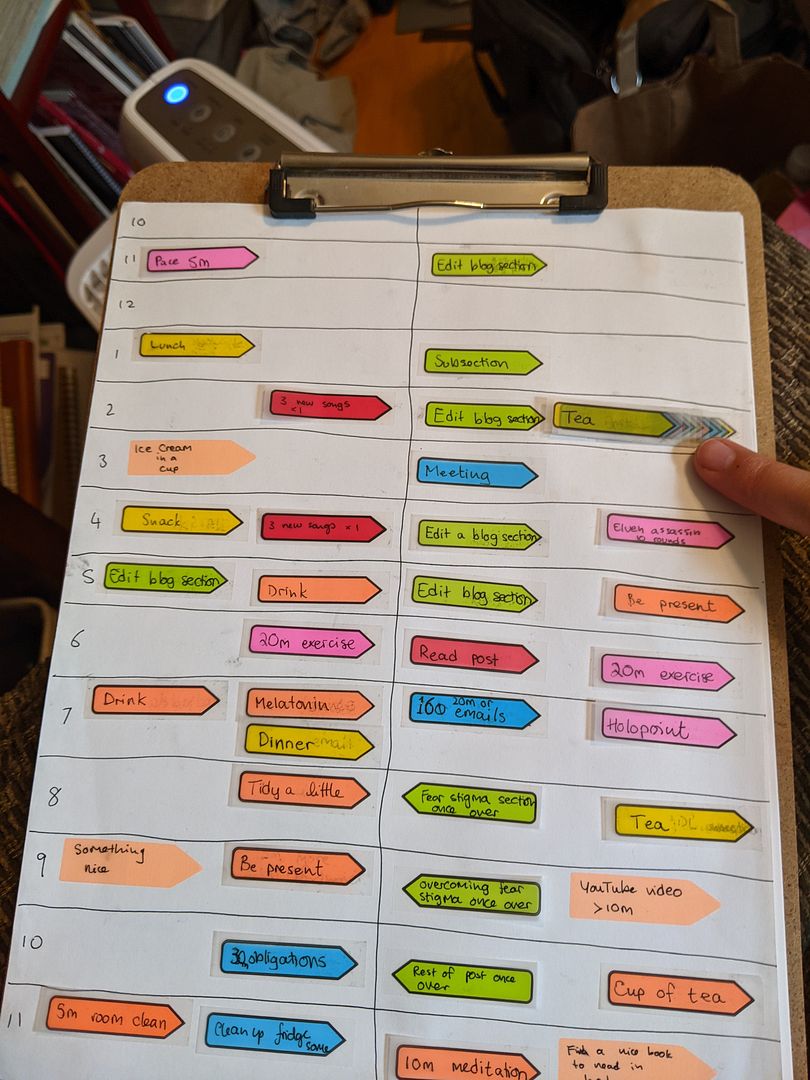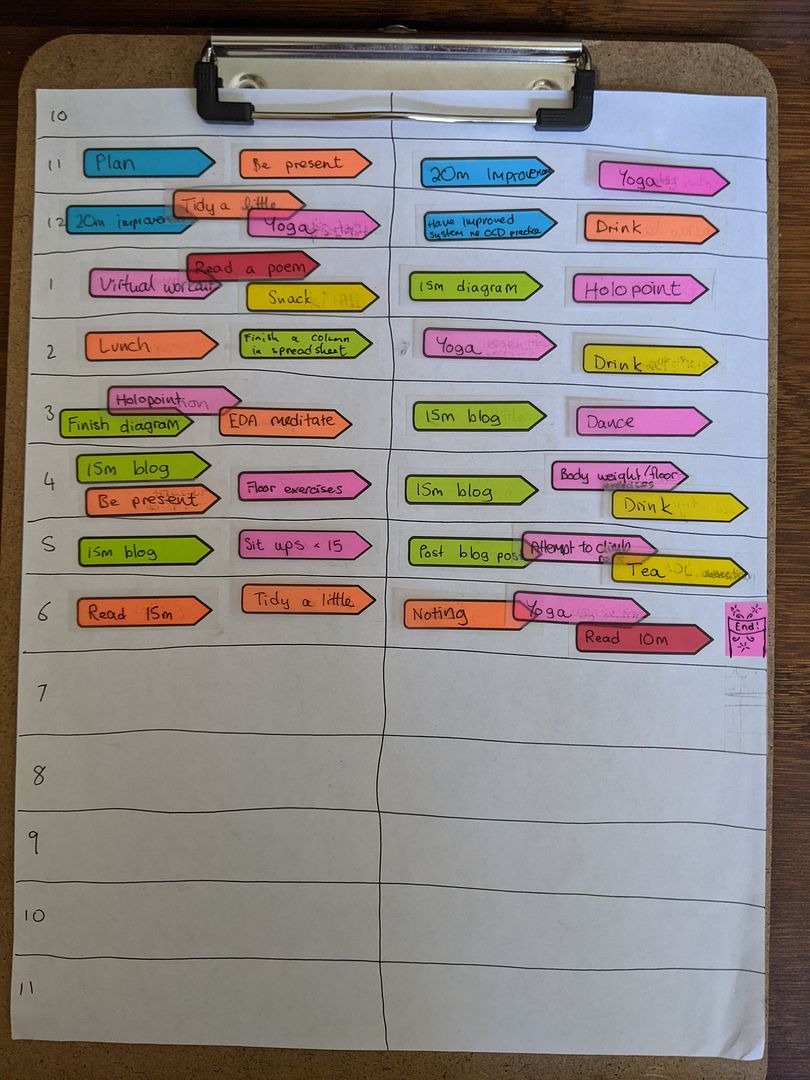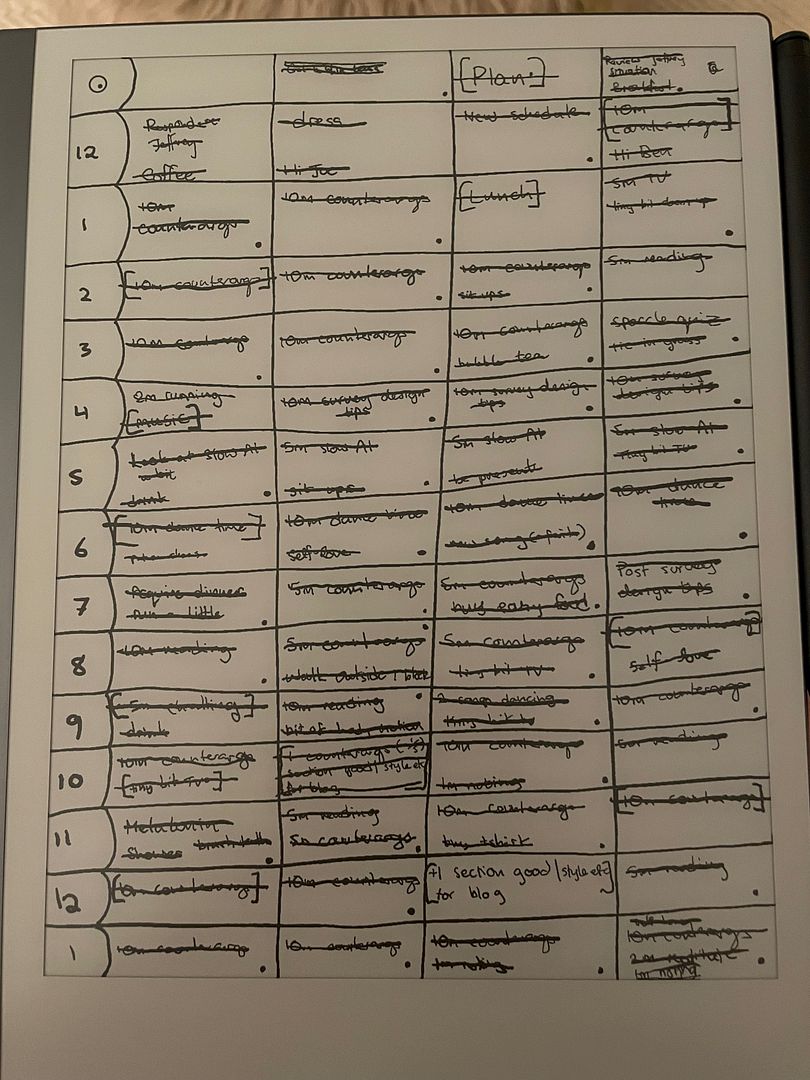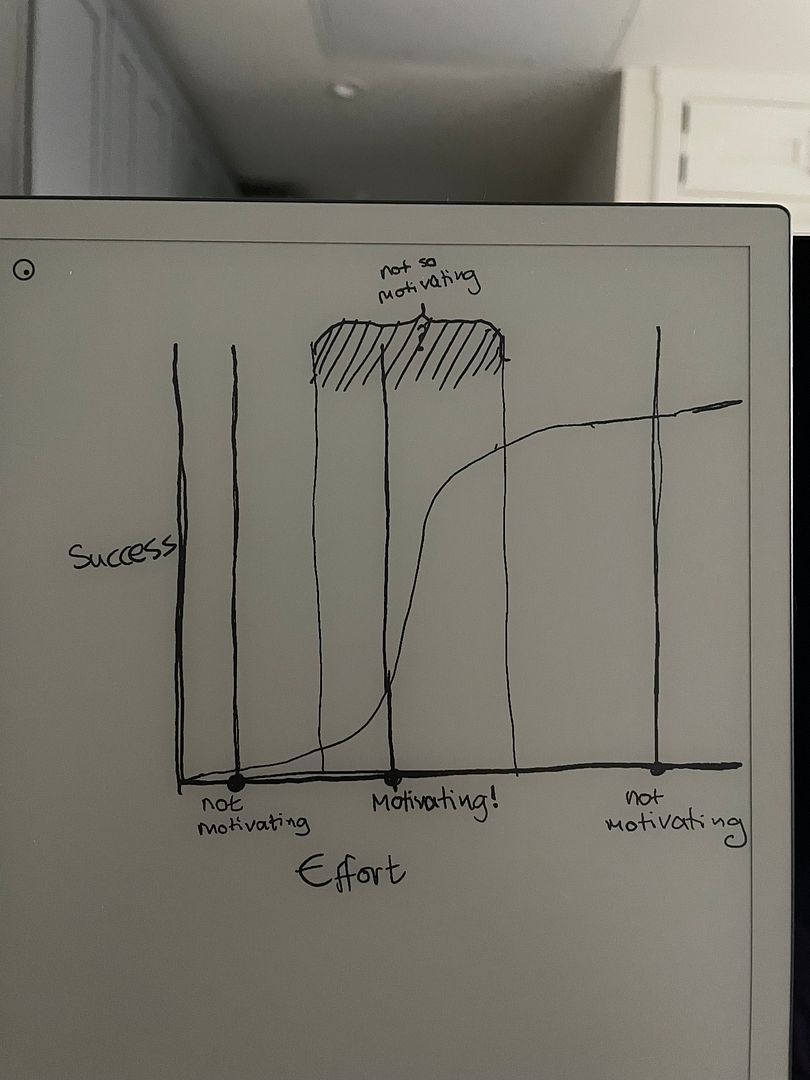A game of mattering
When I have an overwhelming number of things to do, and insufficient native urge to do them, I often arrange them into a kind of game for myself. The nature and appeal of this game has been relatively stable for about a year, after many years of evolution, so this seems like a reasonable time to share it. I also play it when I just want to structure my day and am in the mood for it. I currently play something like two or three times a week.
The game
The basic idea is to lay out the tasks in time a bit like obstacles in a platformer or steps in Dance Dance Revolution, then race through the obstacle course grabbing them under consistently high-but-doable time pressure.
Here’s how to play:
- Draw a grid with as many rows as there are remaining hours in your hoped for productive day, and ~3 columns. Each box stands for a particular ~20 minute period (I sometimes play with 15m or 30m periods.)
- Lay out the gameboard: break the stuff you want to do into appropriate units, henceforth ‘items’. An item should fit comfortably in the length of a box, and it should be easy enough to verify completion. (This can be achieved through house rules such as ‘do x a tiny bit = do it until I have a sense that an appropriate tiny bit has been done’ as long as you are happy applying them). Space items out a decent amount so that the whole course is clearly feasible. Include everything you want to do in the day, including nice or relaxing things, or break activities. Drinks, snacks, tiny bouts of exercise, looking at news sites for 5 minutes, etc. Design the track thoughtfully, with hard bouts followed by relief before the next hard bout.
- To play, start in the first box, then move through the boxes according to the time of day. The goal in playing is to collect as many items as you can, as you are forced along the track by the passage of time. You can collect an item by doing the task in or before you get to the box it is in. If it isn’t done by the end of the box, it gets left behind. However if you clear any box entirely, you get to move one item anywhere on the gameboard. So you can rescue something from the past, or rearrange the future to make it more feasible, or if everything is perfect, you can add an entirely new item somewhere.
I used to play this with tiny post-it stickers, which I would gather in a large moving pile, acting as a counter:


Now I just draw the whole thing. Crossed out = collected; [] = rescued from the past, now implicitly in the final box; dot in the lower right = box cleared; dot next to item = task done but item stuck in the past (can be collected immediately if rescued).

Why is this good?
I think a basic problem with working on a big pile of things in a big expanse of time is that if you work or not during any particular minute, it feels like it makes nearly no difference to the expectation of success. I’m not quite sure why this is—in fact if I don’t work this minute, I’m going to get one minute less work done. But it feels like if I don’t work this minute, I only need to work a smidgen faster on average to get any particular amount of work done, so what does it matter if I work now or later? And if i had some particular goal (e.g. finishing writing some massive text today), it’s unlikely that my other efforts will get me exactly to the line where this minute pushed me over—probably I will either succeed with hours to spare (haha) or fail hours from my goals.
I picture what’s going on as vaguely something like this—there is often some amount of work that is going to make your success likely, and if you know that you are on a locally steep part of the curve, it is more motivating than if you are either far away from the steep part or don’t know where you are:

Yet on the other hand, the appeal of various non-work activities this specific minute might be the most distinct and tangible things in the world. So when there is a lot to be done in a long time, not working often looks more exciting than working, even if a more rational accounting would disagree.
Having a single specific thing to do within minutes is much more compelling: the task and the time are lined up so that my action right now matters. Slacking this minute is the difference between success and failure.
It feels very different to have one email to deal with in three minutes and to have a thousand to deal with in next fifty hours.
One might naively respond to this issue by breaking up one’s tasks into tiny chunks, then laying them out in a day of tiny time boxes, then aiming for each to happen by the end of its allotment. But this will be terrible. A few boxes in, either you’ll be ahead or behind. And either way, your immediate actions have drifted away from feeling like they matter. If you are ahead, the pressure is off: you’ll probably succeed at the next increment whether or not you work hard now. If behind, you are definitely going to fail at doing the next box on time, and probably some others, and your present work is for an increased chance of catching up at some vague future box, much like before you had these boxes. (Plus your activities are no longer in line with what your plan was, which for me makes it tempting to scrap the whole thing and do something else.)
A big innovation of this game is to instead ensure that you keep meeting tasks one at a time where each one matters in its moment, as in a game like Beat Saber or Dance Dance Revolution. The game achieves this by adjusting the slack to keep the next ten minutes’ action near the actually-mattering-to-success region all day. If you get behind you have to give up on items and move forward, so you aren’t left struggling for a low probability of catching up. If you get ahead, you add more items and thus tighten the slack.
A thing I like about this is that it actually makes the activity more genuinely fun and compelling, and doesn’t involve trying to trick or uncomfortably binding oneself. It is superficially a lot like a ‘productivity hack’, but I associate these with somehow manipulating or forcing yourself to do something that you at some level have real reason to dislike. I expect such tricks to fail, and I don’t think I want them to succeed.
This seems different: I think humans are just genuinely better at being in an enjoyable flow state when their activities have certain structures that are genuinely compatible with a variety of tasks. Beat saber wouldn’t be fun if all the boxes were just sitting in a giant pile and you had to beat your way through as many as you could over an hour. But with the boxes approaching one at a time, at a manageable rate, where what you do in each moment matters, it really is fun (for many people, I hear—I actually don’t love it, but I do appreciate this particular aspect). The same thing that makes Beat Saber more fun than Saber-a-bunch-of-boxes-on-your-own-schedule can genuinely also be applied to giant piles of tasks.
The fact that this game has lasted a year in my life and I come back to it with verve points to it not being an enemy to any major part of myself.
Another promising way of seeing this game is that this structure lets you see more clearly the true importance of each spent minute, when you were by default in error. Whereas for instance playing Civ IV for five minutes every time you do work (another sometimes way-of-being of mine) is less like causing yourself to perceive reality truly and more like trying to build an alternate incentive structure out of your mistaken perception, that adds up to rational behavior in the real world.
If anyone else tries this, I’m curious to hear how it goes. My above explanation of its merit suggests it might be of broad value. But I also know that perhaps nobody in the world likes organizing things into little boxes as much as I do, so that could also be the main thing going on.